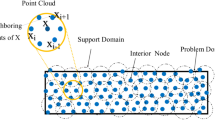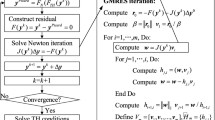Abstract
An online scheme has been developed for the reduction of errors associated with a second order generalized perturbation theory (GPT) approximation of the neutron diffusion fundamental-mode eigenvalue (1/k eff.). The primary application of this work is nuclear fuel loading optimization, where the noted calculation estimates the eigenvalue response as a function of fuel material perturbations (i.e., fuel assembly shuffles) relative to a reference (unperturbed) core loading pattern. The implementation of GPT for approximating k eff can reduce the computational time requirements by a factor of 10 or greater, however, the nature of GPT is such that the errors in the second order approximation grow as the perturbations get larger. Therefore, the main emphasis of this study is to achieve improved approximations of the End-of-cycle (EOC) k eff with minimal increase in the computational time. Specifically, this study shows that an online neural network-based scheme can be applied to reduce the average errors while still maintaining a computational edge over direct eigenvalue calculations.
Similar content being viewed by others
References
J. S. Imbriani, P. J. Turinsky, and D. J. Kropaczek. Generalizedperturbation theory error control within PWR core-loading pattern optimization. Trans. Am. Nucl. Soc., 71:261–262, 1994.
H. G. Kim, S. H. Chang, and B. H. Lee. Pressurized water reactor core parameter prediction using an arti.cial neural networks. Nuclear Science and Engineering, 113:70–76, 1993.
S. Kirkpatrick, C. Gelatt, and M. P. Vecchi. Optimization by simulated annealing. Science, 220(4598):671, 1983.
D. J. Kropaczek and P. J. Turinsky. In-core nuclear fuel management optimization for pressurized water reactors utilizing simulatedannealing. Nuclear Technology, 95(9):9–32, 1991.
M. G. Lysenko, H. I. Wong, and G. I. Maldonado. Neural network perturbation theory hybrid models for eigenvalue prediction. Nuclear Science and Engineering, 132:78–89, 1999.
M. G. Lysenko, H. I. Wong, and G. I. Maldonado. Predicting neutron diffusion eigenvalues with a query-basedad aptive neural architecture. IEEE Transactions on Neural Networks, 10(4):790–800, 1999.
G. I. Maldonado and P. J. Turinsky. Application of nonlinear nodal diffusion generalized perturbation theory to nuclear fuel reloadoptimization. Nuclear Technology, 110(2):198–219, 1995.
G. I. Maldonado, P. J. Turinsky, D. J. Kropaczek, and G. T. Parks. Employing nodal GPT for the minimization of feedenrichment in nuclear fuel management optimization. Nuclear Science and Engineering, 121:312, 1995.
G. T. Parks, P. J. Turinsky, and G. I. Maldonado. Solving the PWR reload core optimization problem. Scientific Excellence in Supercomputing: The IBM 1990 Contest Prize Papers, p. 281. Baldwin Press, Athens, GA, 1992.
A. Rawat. Predicting perturbation theory errors in nuclear core power distributions using artificial neural networks. Master's thesis, Iowa State University, Ames, Iowa, 1998.
SNNS. Stuttgart Neural Network Simulator Version 4.2, Institute for Parallel andDistributedHigh Performance Systems, University of Stuttgart, Germany, 1995.
E. L. Wachpress. Historical review of group diffusion computation. Transactions of American Nuclear Society, 66:240, 1992.
S. E. Wendt, G. I. Maldonado, and E. B. Bartlett. Predicting critical boron concentration in a PWR using an arti.cial neural network. Trans. Am. Nucl. Soc., 72:149, 1995.
H. I. Wong and G. I. Maldonado. Adaptive neural network error control for generalized perturbation theory. Trans. Am. Nucl. Soc., 75:174–175, 1996.
Author information
Authors and Affiliations
Rights and permissions
About this article
Cite this article
Maldonado, G.I., Kondapalli, N. Online Higher-Order Error Correction of Nonlinear Diffusion Generalized Perturbation Theory Using Neural Networks. The Journal of Supercomputing 23, 185–192 (2002). https://doi.org/10.1023/A:1016500528717
Issue Date:
DOI: https://doi.org/10.1023/A:1016500528717




